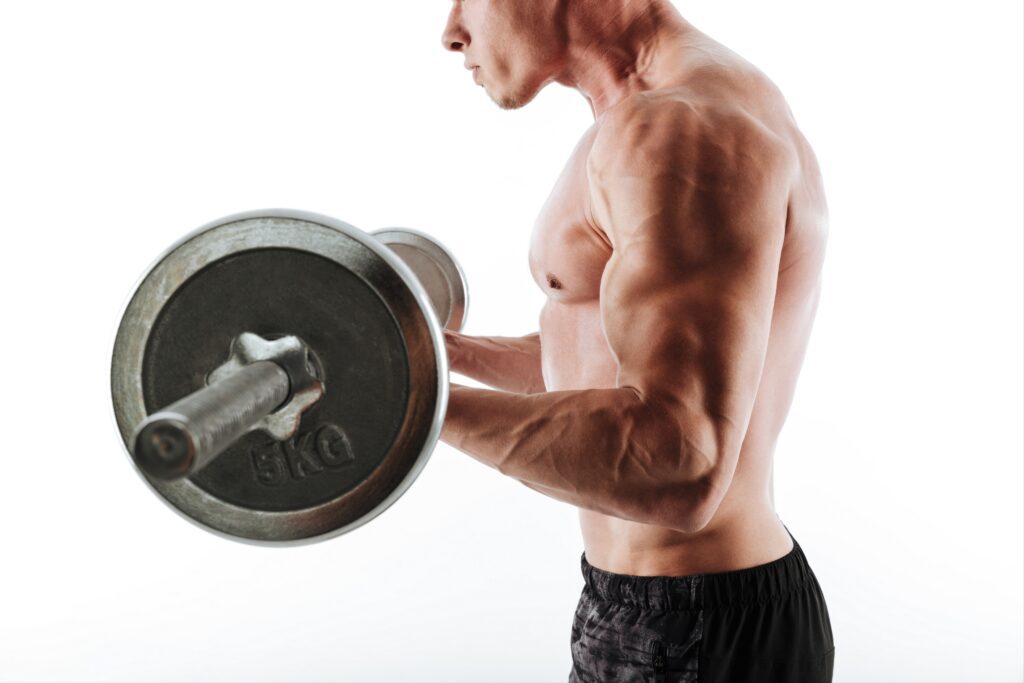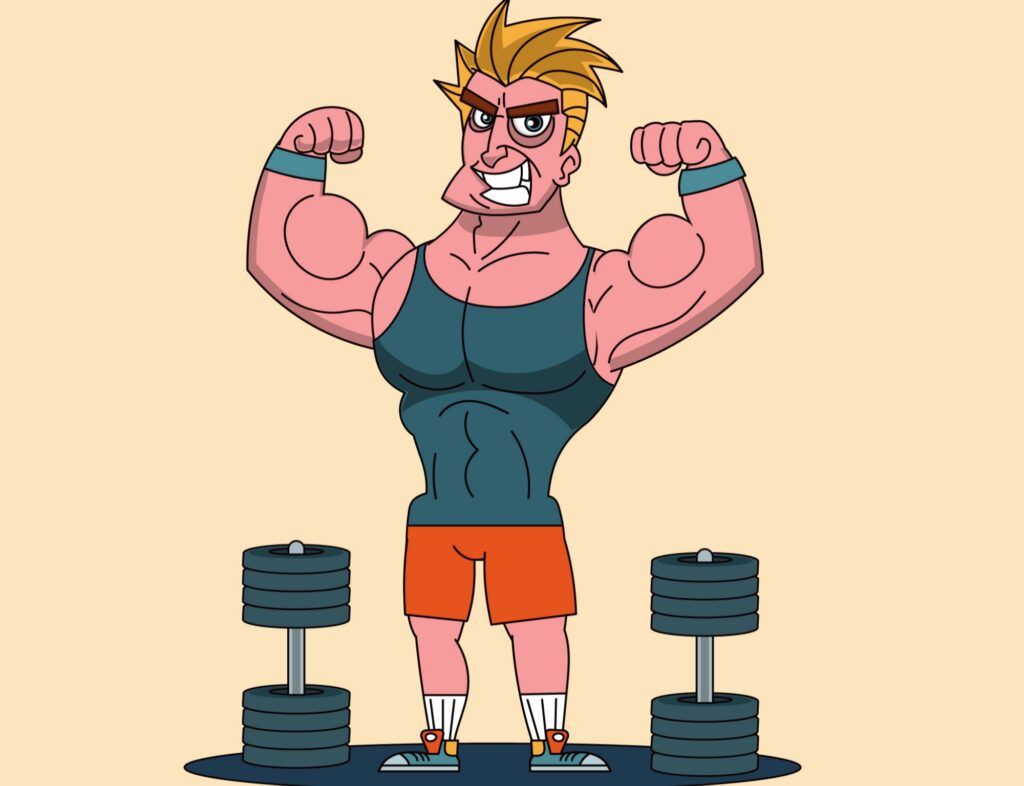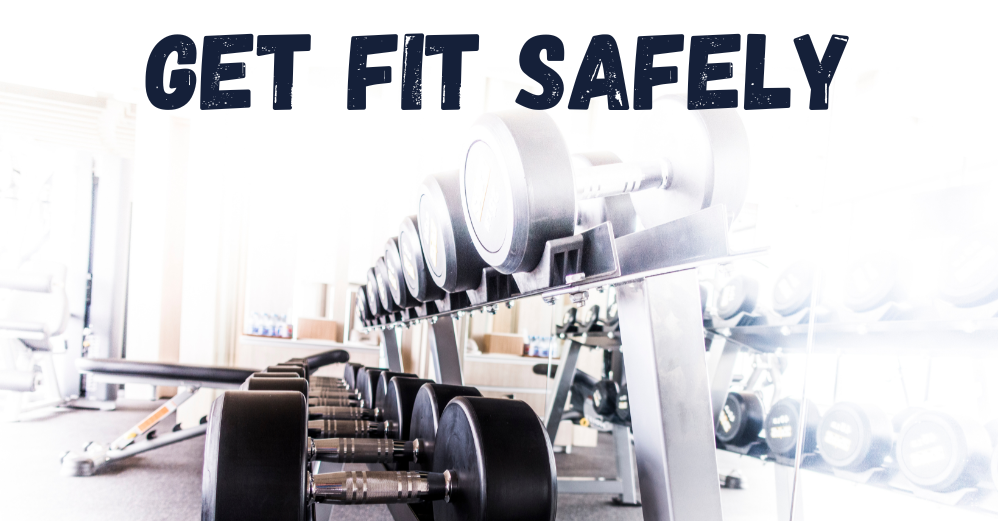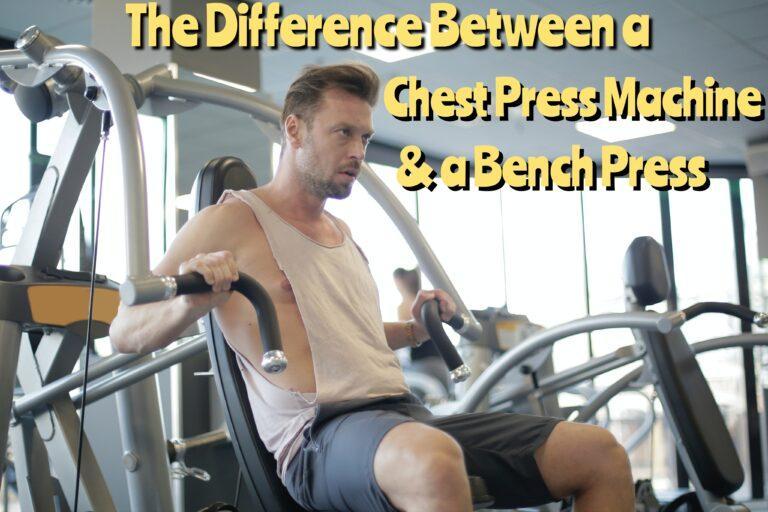I asked myself this question the first time I started feeling some aches in my biceps during heavier curls.
I wanted tough biceps, but without constantly battling discomfort and inflammation.
So I decided to give lighter weights and high reps a chance.
And, to be honest, I did notice a few advantages.
But it’s not all sunshine and roses.
Let’s take a look at the pros, cons, and everything surrounding this training strategy.
What types of workouts are done at the gym?
There’s a whole world of possibilities in the gym.
But, in a nutshell, we could break down the main training types into:
- Strength training – High loads, low reps (from 1 to about 5-6).
- Traditional hypertrophy – Moderate loads, moderate reps (8-12).
- Muscular endurance – Lighter loads, high reps (15+).
- Functional training – Bodyweight or moderate loads, focusing on coordination and explosiveness.
- Circuit training – A mix of exercises in sequence, varying intensity, focusing on overall conditioning.
I’ve tried a bit of everything myself.
But today we’re focusing on the more “light” approach and seeing how it affects biceps resilience.
Muscle fibers and the hormones involved
If there’s one thing I’ve learned, it’s that not all muscles are the same.
Simply lifting something and expecting them all to grow in the same way doesn’t work.
Inside those biceps are different fibers, and how you train them changes everything.
Muscle fibers: who’s really working when you lift?
- Type I fibers (slow): the tireless ones. Perfect for enduring fatigue, but not for explosiveness. If you’ve ever done a set of 20 reps and felt that burning sensation, know that they were the ones working.
- Type II fibers (fast): the explosive ones. They’re divided into IIa (somewhere between strength and endurance) and IIb, the most powerful but also the quickest to fatigue. They make the difference when you need to lift a significant weight.
With lighter weights and lots of reps, you mostly train type I fibers and part of IIa.
So you improve muscle endurance, not so much maximum strength.
Basically, if you do curls with light dumbbells until your biceps catch fire, you’re becoming more resistant to fatigue, but not stronger in an absolute sense.
If instead you lift heavy weights with fewer reps, the focus shifts to the type II fibers.
They’re the ones providing power and muscle size.
After 5-6 reps with a tough load, your central nervous system is already under pressure.
This type of training is what helps you lift more weight and build real strength.
Hormones and muscle growth: what happens inside the body?
This is where body chemistry comes into play.
Training isn’t just about muscle fibers—it’s also about hormonal response.
Research shows that progressive resistance training—gradually increasing weight, reps, or intensity—stimulates testosterone and GH release.
These hormones drive muscle growth and speed up recovery.
On the other hand, higher-rep training builds overall volume, leading to a steady release of IGF-1 (insulin-like growth factor), which supports muscle repair.
While it doesn’t trigger the same immediate hormone surge as heavy lifting, it still promotes muscle growth over time.
Schoenfeld (2016) confirmed that both heavy and moderate loads can stimulate hypertrophy, as long as training approaches muscle failure.
More recent research (Lasevicius et al., 2019) supports this, highlighting that muscle failure is crucial for hypertrophy with light loads but offers no extra benefit with heavy loads.
The advantages of lifting lighter weights with high reps

When I lowered the weight and increased the reps, I realized something: less load doesn’t mean fewer results.
In fact, I started training better and more frequently, without destroying my joints.
Here are the three benefits that made me appreciate this approach.
1# Less stress on joints and tendons
Before, after every heavy session, my elbows would complain.
Nothing major, but that constant nagging feeling told me that something wasn’t right.
By lowering the load and increasing the reps, the work became more gradual, without sudden shocks to tendons and joints.
The result?
No more small chronic pains and less risk of inflammation.
2# Better mind-muscle connection
With heavy loads, I often ended up using more shoulders and back than biceps.
By reducing the weight, I felt the muscle working much more.
- Controlled eccentric phase: no more weights dropping like a rocket.
- More continuous tension: the pump was more intense.
- No cheating: only the right muscle did the work.
After trying slower, more controlled curls with less weight, I realized that sometimes “more” isn’t better, it’s just heavier.
3# More training frequency (without destroying myself)
When I used to train heavy all the time, I felt I needed more days to recover after each session.
With higher reps, however, I recovered faster and could train more often without feeling wrecked.
And we know that more stimuli = more growth.
If you can hit a muscle more times a week without overdoing the stress, you already have a huge advantage.
Disadvantages of lifting lighter weights with high reps
As much as I like the idea of training with lighter weights for certain periods, I must admit it’s not all perfect.
- Boredom and monotony: After a while, doing 20 or more reps per set can become boring.
- Slower progression: If I’m looking to increase maximum strength, lighter weights aren’t the quickest route.
- Plateau: Sometimes, even increasing the number of reps, I don’t feel that leap in quality and I seem to stop progressing.
There’s a threshold beyond which further increasing reps becomes counterproductive: the muscle and the mind get tired and I notice my concentration drops.
It’s almost like doing cardio with a barbell in hand.
At that point, I feel the need to return to a more “old school” approach: heavy weights and fewer reps.
The benefits of lifting heavier weights with fewer reps

Lifting serious weight isn’t just about ego or wanting to make noise in the gym with the bar hitting the floor.
It’s a precise strategy, used by those who want to build true strength, muscle density, and advanced neuromuscular adaptations.
But the benefits go beyond simply “being stronger.”
1# You improve coordination and movement control
One thing I noticed when I started lifting heavy?
Each rep becomes a matter of absolute precision.
You can’t get distracted, you can’t cheat with momentum, and you definitely can’t afford poor movement.
When you work with 90% of your max, every little mistake is felt that much more.
If your technique is lacking, you’ll realize it right away (or worse, your joints will realize it the next day).
That’s why lifting heavy forces you to become more efficient in your movements, improving motor control and neuromuscular coordination.
And this advantage doesn’t just apply to the gym.
If your body learns to handle heavy movements with precision, everything else—from sports to daily life—becomes easier.
2# You build denser muscles (and stronger bones)
Another thing no one tells you?
Training with heavy loads doesn’t just make your muscles bigger, it makes them denser and harder to the touch.
I’m not talking about that swollen look from a temporary “pump.”
I’m talking about solid muscles, the kind that feel like marble even when you’re at rest.
3# You get strong in everything, not just in the gym
Another thing that struck me is how pure strength translates into every aspect of life.
- If you play sports, you become faster and more explosive.
- If you do manual work, lifting boxes or tools becomes a breeze.
- If you do bodyweight training, you can handle movements like weighted pull-ups and dips more easily.
The strength built with heavy weights isn’t just useful for showing off a record max.
It’s a resource for everything you do.
I’ve noticed that high-rep sets also improve when I’m stronger.
If before I was wrecked after 12 reps, once I’ve worked on strength, I can do more without fatigue and without losing form.
In short, the stronger you are, the easier everything becomes.
4# You burn more calories even at rest
A lot of people think that lifting light weights for a ton of reps is the best way to “get defined.”
But here’s the plot twist: high-intensity training with heavy weights activates your metabolism even after you’ve finished.
There’s a phenomenon called EPOC (Excess Post-Exercise Oxygen Consumption), or the famous afterburn effect.
The more your body has to recover from the effort, the more calories it continues to burn even when you’re on the couch watching Netflix.
A study published in Medicine & Science in Sports & Exercise showed that high-intensity workouts elevate metabolism after training.
While it didn’t compare heavy and light weights directly, most trainers agree that lifting heavier amplifies this effect due to greater muscle recruitment and effort.
Disadvantages of lifting heavier weights with fewer reps
Lifting heavy has its charm.
The adrenaline before a tough squat, the satisfaction of seeing the bar move when it all seemed impossible.
And let’s face it, nothing makes you feel stronger than adding plates and seeing people in the gym give you looks of respect mixed with fear.
But… there’s always a but.
Because while heavy-load training has many benefits, it can also make you pay a price, and it’s not always pleasant.
1) More weight, more risk (and your body reminds you)
If there’s something I’ve learned over time, it’s that the weight doesn’t forgive.
With a light load, you can afford some mistakes.
With a heavy load?
Every little error feels like a fine at the end of the month.
It took me just one squat with my back out of position to realize that some mistakes you don’t make twice.
And the worst part is that injuries don’t always come with an explosive, dramatic crack.
Sometimes they build up slowly:
- A knee twinge you used to ignore that becomes a regular unwelcome guest.
- A shoulder that starts complaining every time you lift your arms.
- An elbow that decides to boycott your curls mid-set.
By then, you can only take a forced break… or learn the lesson earlier.
2) It drains your brain (literally)
Here’s something nobody tells you:
Lifting heavy doesn’t just tire your muscles, it also tires your brain.
There have been days when, after a heavy deadlift session, I felt more wiped out than after a sleepless Netflix marathon.
It’s not just physical exhaustion; it’s as if my nervous system decided to go on standby for the rest of the day.
And you know what happens when the central nervous system is shot?
- You feel slower at everything (even answering texts becomes a chore).
- Your body doesn’t recover as well, so the next workout might be rough.
- Motivation? Down the drain.
Sometimes, after a heavy session, the only weight I want to lift is my fork.
3) Slower progression (and plenty of frustration)
In the beginning, everything seems amazing.
Every week you add weight to the bar and feel like a beast.
Then, suddenly, you reach the point where even adding 5 pounds becomes agony.
If you’re doing higher reps, you can always play with variables like:
✅ Increasing the reps.
✅ Shortening rest times.
✅ Improving technique to really feel the muscle.
With heavy loads, though, either you increase the weight or you stay stuck.
And when you stall at the same max for weeks, your desire to work out drops faster than a barbell without clips.
4) It’s not the best for muscle growth (if you want size and pump)
If there’s one thing I’ve learned, it’s that strength isn’t everything if you also want bigger muscles.
Doing only 3-5 reps makes you strong, sure, but if you want big arms that stretch your sleeves, you also need to work in the 8-12 rep range.
Why?
- Time under tension is lower with fewer reps.
- Your muscles get a different stimulus from classic hypertrophy training.
- The pump? Forget it.
If you’re aiming for that classic bodybuilder muscular look, always lifting heavy isn’t enough.
You need a mix of strength and volume.
Is Lifting Heavy Really That Risky? Science Says No

Ever heard someone say, “Careful with those heavy weights—you’ll wreck your joints!”?
Turns out, that’s more gym myth than fact.
A study in Sports Medicine (Keogh et al., 2017) analyzed injury rates in different weight-training sports—powerlifting, weightlifting, bodybuilding, strongman, Highland Games, and even CrossFit.
The results?
Lifting heavy isn’t as dangerous as most people think.
Bodybuilding had some of the lowest injury rates, while strongman and Highland Games had the highest (probably because flipping tires and throwing logs isn’t exactly low-impact).
But even at the top end, the injury risk was still lower than in sports like soccer or basketball.
The most common issues?
Strains, tendinitis, and sprains—stuff that usually comes from poor form or overuse rather than the weight itself.
So, what’s the takeaway?
If you lift smart, listen to your body, and don’t let your ego load the bar, heavy lifting is a lot safer than you think.
When do high reps become too many?
I’ve gone from 15 reps to 20, then to 25, and… I no longer felt substantial improvements; in fact, I felt the opposite.
There comes a point where the fatigue becomes more cardiovascular than muscular, and the biceps don’t get that “strong” stimulus they need to grow or get stronger.
It’s like I’m doing endurance, not strength or hypertrophy.
So if I notice I’m no longer progressing, or I spend more time battling boredom than improving, that’s the sign I need to change the scheme.
Example of a workout with lighter weights and high reps
- Dumbbell curls: 3-4 sets of 15-20 reps. Rest: 45-60 seconds.
- Hammer curls: 3 sets of 15 reps. Rest: 45 seconds.
- Incline bench curls: 2-3 sets of 15 reps, focusing on the eccentric phase.
The goal here is to maintain constant tension.
No cheating, maintain form, and push the biceps to a “controlled” failure.
All of this without having to lift record-breaking loads.
Example of a workout with heavier weights and low reps
- Barbell curls: 4-5 sets of 5-6 reps. Rest: 90-120 seconds (to fully recover).
- Chin-ups (underhand grip): 3 sets of 4-6 reps, perhaps adding weight with a belt.
- Alternating dumbbell curls: 2-3 sets of 6-8 reps, aiming for a challenging load.
In this case, the priority is pure strength.
Every rep is done carefully, but here the goal is to move a load that really tests the biceps and the entire musculoskeletal system.
Train your whole body, not just your biceps
I learned the hard way that you can’t live on biceps alone.
To make your arms resilient, you have to work on shoulders, core, back, and legs.
Everything is connected, and having a stronger overall body lowers the chance of injuries.
Examples of compound exercises I love:
- Squats (with a barbell or dumbbells)
- Bench Press
- Deadlifts (conventional)
- Military press
- Barbell rows
These multi-joint movements engage multiple muscle groups and help build a solid base.
A stronger overall structure allows the biceps to work with more stability, reducing the risk of setbacks.
RELATED:>>> Leg Day Dilemma: Heavy Weights with Low Reps or Light Weights with High Reps?
Conclusion
More reps with less weight can be an excellent strategy for reinforcing the biceps and making them more resistant to injuries.
Less load = less direct stress on elbows and tendons.
But watch out: it’s not an absolute guarantee.
If you overdo the volume or ignore technique, you can still land in trouble.
Doing 30 reps with poor form is more harmful than doing 10 reps with perfect control.
To stay safe, it’s better to alternate phases of moderate weights and lower reps, so your muscles adapt without wearing out.
And remember: it’s how you train that matters most, not just how many reps you do.
Faqs
Does doing more reps with lighter weights help with weight loss?
It can help, but it’s not the most effective way to lose fat. Light weights burn calories during the workout, while heavy lifting keeps the burn going after. Either way, without a calorie deficit, results will be limited. Focus on diet first, paired with intense training.
Should someone with elbow pain avoid heavy weights and low reps?
If the pain is due to joint stress or inflammation, lifting heavy loads can worsen the situation. It’s better to reduce the load, increase the reps, and pay close attention to form. If pain persists, stop and consult a professional.
Does lifting light weights with high reps “tone” more than heavy weights?
No, there’s no such thing as “toning” in a scientific sense. You either build muscle or lose fat. Lighter weights help with muscle endurance, but if you want more defined muscles, it’s about a caloric deficit and body fat percentage.
Do more reps help improve blood flow to the muscles?
Yes, higher rep sessions increase blood flow to the muscles and can provide a better pump. This can improve tissue oxygenation and the removal of metabolites, but it doesn’t replace heavy-load work for muscle growth.





